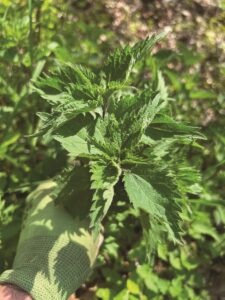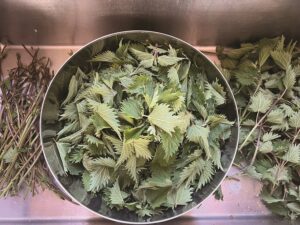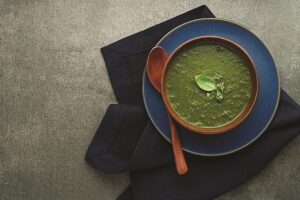Once again, I sigh as I browse the produce aisle at the grocery store. There, standing between me and the blueberries or kale or lettuce, is so much plastic. Those rigid lettuce boxes seem like the worst. And I can’t even get my hands directly on green beans anymore, which now come in pre-measured bags to accommodate the needs of Instacart, I guess.
I know that whatever plastic I bring home will go directly into the recycling, and from there, who knows? I look at it and wonder if it will end up in the Great Pacific Garbage Patch swirling somewhere between California and Japan.

Spring brings relief here for many reasons, not least of which is the fact that we can begin to turn away from those egregious boxes and bags that imprison our produce. Early lettuces are coming up in my kitchen garden, and soon the farmers’ markets will open. And there are wild greens to be foraged. So far, I’ve found ramps, of course, and also cresses, mustards, and knotweed. But what I’m excited about right now are nettles — the stinging kind. They practically leap from the ground at this time of year.
My friend and foraging mentor, Ingrid Bratberg, introduced me to these amazing greens, and I have her bright stinging nettle soup in mind for supper tonight. Yesterday, I made a pot of beans for the occasion — they’ll give the soup body. Today I’ll amble south of where I live on Old County Road to pick from a large stand of stinging nettles I’ve been watching.
Urtica dioica, the common nettle or stinging nettle, is a perennial weed — or so we call it in these parts — whose name derives from the Latin uro, “to burn.” Its leaves bear tiny hollow hairs whose tips come off when touched and act like tiny needles, injecting the plant’s formic acid and other chemicals into the skin. So, I’ll have on blue jeans to protect my legs, not only from ticks but also from the prickly effect of the nettles. I carry with me a pair of sturdy gloves, some garden shears, and a grocery bag.
Nettles have long been eaten and used as a component in traditional medicine. The prickly leaves are packed with minerals including iron and calcium as well as vitamins A and C, plus they have antioxidant compounds and anti-inflammatory characteristics that are becoming appreciated in modern medicine.

But you don’t have to be a scientist to know that greens are good for you and, anyway, I love nettles for the flavor, texture, and color. A brief exposure to high heat tames the plant’s stinging spines and transforms the leaves into a bright, flavorful edible green. Many compare nettles to spinach, but I’d say nettles are more vegetal, if that’s possible, and their leaves have a desirable thickness. They’re chewier than spinach (although it’s possible I’ve become so accustomed to the insipid supermarket “baby spinach” that I’ve forgotten what robust garden spinach is like).
Nettles need nothing more than a quick sauté in olive oil and garlic. They’re also great as a component in pasta sauce, an element of a grain bowl, or a topping on pizza for a hit of brilliant green. Dried, the leaves make a flavorful tea, extending their use well past their growing season. Outer Cape food maven Elspeth Hay told me that she blanches nettles and freezes them and then uses them throughout the winter to make spanakopita — that’s genius.
I’m blanching and freezing nettles now to use later in the summer to make Rockefeller-style grilled oysters.

For Ingrid’s nettle soup, I use dried garbanzo beans because the bean broth makes the soup so much better. I cook an entire pound and freeze what isn’t needed for this recipe to have at the ready for next time. But there’s no sin in using canned beans if time is an issue.
You may have your own way of cooking a pot of chickpeas. You can soak them overnight or not. I do, and I also follow the advice of biologist and cookbook author Nik Sharma and add 1½ tablespoons of kosher salt (Diamond Crystal) and 1 teaspoon of baking soda to the brine to improve the texture of the cooked beans. Drain the beans, cover them with a few inches of fresh water, and simmer. I flavor mine with a bay leaf, half a peeled onion, and a clove or two of peeled garlic. Simmer, uncovered, until the beans are done but still al dente and then proceed with the recipe.
Green Nettle Soup
8 servings
3 cups of cooked chickpeas, with their broth (or 2 15-oz. cans)
3 Tbsp. extra virgin olive oil
2 yellow onions, chopped
1 large leek, rinsed well and chopped (or 1 large shallot, chopped)
4 cloves garlic, minced
1 large carrot, chopped
½ cup dry white wine or vermouth
2 quarts vegetable stock or water
1 or 2 large thyme sprigs
1 bay leaf
2 to 3 quarts of rinsed fresh nettle leaves
2 Tbsp. white miso
Salt and pepper
A few wedges of lemon
Mixed soft herbs (parsley, chives, dill, basil, mint, tarragon), chopped, and toasted pumpkin or sunflower seeds for the garnish
- Once the beans are cooked (or the canned beans opened), warm the olive oil in a large pot, add the onions, and cook until translucent. Add the leek or shallot, garlic, and carrot, and cook for another minute or two. Season aggressively with salt and pepper. Add the wine and cook until most of it has evaporated.
- Add the beans and their broth to the pot along with enough additional vegetable broth or water to cover the beans by about 3 inches. Add the thyme and bay leaf. Bring to a low boil.
- Add the nettles or other greens to the pot and simmer briefly until they soften. The longer they cook the darker the green will be. While the flavor is the same, I like the brightness of just-wilted nettles.
- Allow the soup to cool enough to be handled and then purée in batches in a blender or, easier, use an immersion blender in the soup pot.
- Whisk in the white miso and adjust seasoning as needed. Ladle into serving bowls, give each bowl a squeeze of lemon juice, and garnish with the chopped herbs and seeds.
